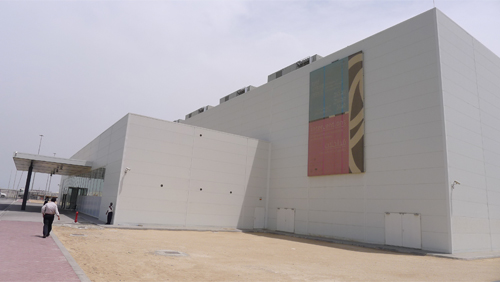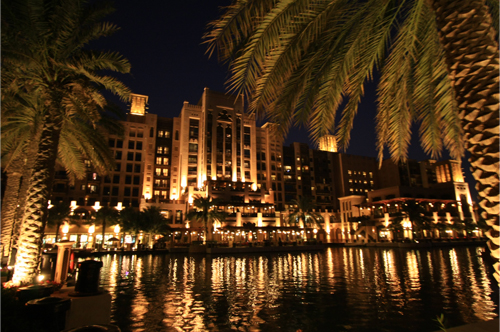Mori Art Museum presents "Arab Express: The Latest Art from the Arab World" (16 June - 28 October, 2012).
Last time, we asked Nanjo to talk about how the Arab world had changed since the 1970s, when he first conducted research there. This time around we asked how Arab art fits within the international art scene.
- How does Arab art fit within the international art scene?
Nanjo: I think this is the beginning and that in future you are going to see more and more Arab art stepping onto the international stage. Of course, it is already receiving a lot of attention, but it hasn't got to the point where Chinese contemporary art is, where it dominates the market and everyone knows about it. But the quality of the work is improving greatly. I think it is time for it to bathe in the spotlight.

Nanjo Fumio (Director, Mori Art Museum)
In terms of "human exchange," I don't know the actual migration trends so I can't say categorically nor clearly, but if you look at a country like Lebanon, it had a very long civil war and during those 20 years a significant proportion of its population fled overseas. But those people are now working overseas, sending money back to their families in Lebanon.
So whereas in the past any Westernization or Modernization was the result of the West imposing itself on the region, now you have a situation where people who have left their countries are picking up Western habits and culture overseas and then eventually taking those home with them and internationalizing their own countries. And the same thing is happening with contemporary art. People are starting to understand it more deeply, as their own form of expression.

Mathaf: Arab Museum of Modern Art (opened in 2010)
- In that way, contemporary art in the Arab world today is being made by artists who understand Western contemporary art, but who at the same time want to make their own form of expression in response to their own society.
Nanjo: Yes, I think so. Contemporary art is an international language and so if you have that international vocabulary then you can make a richer form of expression. But, of course, it's also very important to know your own country's traditional culture. Through the combination of these, a kind of chemical reaction can be achieved that produces a unique, new kind of artwork that is rooted in that country or that society.

Zena el Khalil
Xanadu, Your Neon Lights Will Shine
2010
Acrylic paint on canvas, fabric, glitter, kufiya cloth,
bead, sequin, pompon, artificial flower, photocopy,
insulation board in gold leaf frame
183 x 215 x 19 cm
Courtesy: Galerie Tanit, Munich
Photo: Christoph Knoch
- That kind of phenomenon also occurs in Asia, too. Why is it that Japan should focus on Arab contemporary art?
Nanjo: At the moment there has been a boom for Asian contemporary art. An extremely large market has developed around Chinese contemporary art and there are now numerous artists who sell artworks for more than 100 million yen a piece.
In this context, there are people in the West who got curious and began to ask, "OK, what about Arab art? Won't it follow the same path?" I think they were expectant that the large region between Europe and Asia would be next to produce something big.
And if you look at this from a historical perspective, much of the Middle East was divided up between the great European powers as colonies. And so in countries like France and Britain, there is still a feeling of familiarity there and this translates into a desire to exhibit those countries' art in their museums. Hence over the last five or six years there have been many exhibitions of Arab contemporary art in London and Paris.

Art Fair "Art Dubai"
And yet in Japan, Arab contemporary art has almost never been exhibited. And that's why with this exhibition I wanted to introduce it promptly, from a "journalistic" standpoint.
And then there is also the economic perspective. The Arab world and Japan have extremely deep economic ties. Oil is of course necessary, but Japan is also exporting many manufactured goods/products to the region, so there is a relationship of mutual dependence. For that reason, too, I think it's important for the Japanese to understand the culture of the Arab countries.
- Are there any particular subjects or forms of expression that are particularly unique to Arab contemporary art?
Nanjo: In the Arab world there is of course Islam and Islam prohibits idolatry. That is to say, human being are the creation of God, and so for human beings to create a picture of one of God's creations would be sacrilegious.
And so within the Middle East, or at least within the Muslim cultures of the Middle East, the primary form of artistic expression was traditionally geometric patterns. Hence, the term "Arabesque." And because of this tradition, you continue to see a lot of abstract expression in contemporary Arab art.

"Arabesque" to decorate Mosque
By Sebastiá Giralt
I once met a young female artist who was putting variously colored dots in a painting. When I asked her what they were she answered, "This is a person, and when there are a lot of them together they form a society." Another artist made a mathematical equation and used it to create a geometrical, abstract painting. I sense that there is this way of thinking that is systematic, mathematical and, in a way, abstract. I don't think that kind of approach is prominent in Japan.

Hassan Sharif, artist known to be the "father of Arab Contemporary Art"
And there is another characteristic. There are a lot of artists who create artworks dealing with experiences or memories of the kinds of conflicts and wars that are particular to this region. In Lebanon, there are artists that created a famous photography archive called the "Arab Image Archive." These people want to record the photographs, and thus the experiences of their own society. I believe this is the kind of project that has been born out of the peculiar circumstances of the Middle East.
■Relevant information
・Interview: Nanjo Fumio on "Arab Express"
Part 1 Comparing the Arab world of the 1970s with that of today
Part 2 Why is the world fascinated with Arab contemporary art?
Part 3 An exhibition to encourage cultural diplomacy, mutual understanding
・Interview: Kondo Kenichi on "Arab Express"
Part 1 Want to show Japan the diversity of the Arab world
Part 2 Exhibition highlights: Black Fountain and "Arab Lounge"
・"Arab in One Minute"
File-01 The Arab World on Screen
File-02 My first time at the cafe, the meeting place of men
File-03 Lamb or Chicken, That Is the Question / Cuisine and Hospitality
File-04 Ruins from Time Immemorial: Mesopotamia, the Birthplace of Civilization
File-05 The Beauty is in the Geometry: Calligraphy and Arabesque
"Arab Express: The Latest Art from the Arab World" introduces the work of about 30 artists from the Arabian Peninsula and surrounding Arab countries. This exhibition will bring you up to date with the latest developments from an art scene that is now the focus of international attention.
・Arab Express: The Latest Art from the Arab World
16 June - 28 October, 2012








